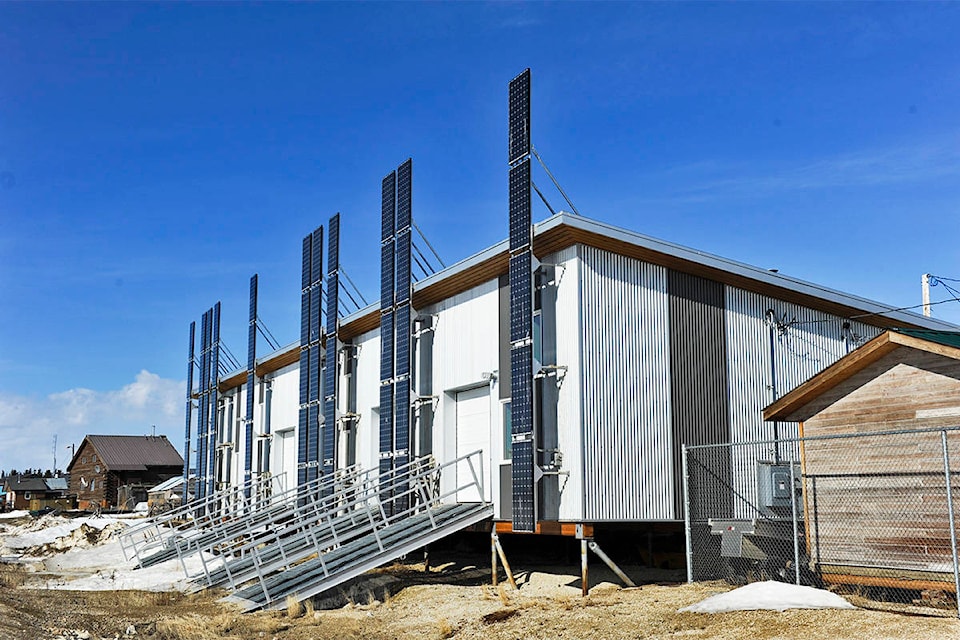A new report from the Pembina Institute has given the Yukon top marks when it comes to transitioning remote Indigenous communities away from diesel energy.
The report from the climate change policy think tank titled, “Power shift in remote communities: a cross-Canada scan of clean energy policies,” measured provincial and territorial governments’ directional policies, utility policies and community engagement work to determine their progress in transitioning from diesel.
Yukon’s report card got near-perfect marks, with only “incentives and/or financing for clean energy and energy efficiency” receiving a yellow-circle score, indicating “some policy in place.”
In terms of policies, the report praised the government’s ability to meet its 2012 goal of reducing diesel emissions by 20 per cent by 2020. It also highlighted their Good Energy Yukon and Community Green Energy Initiatives programs, which both fund and provide incentives for clean energy projects.
The Yukon government’s collaborations with self-governing First Nation were lauded for their opportunities for First Nations to lead their own clean energy projects, including the Vuntut Gwitchin First Nation’s solar project in Old Crow and the Kluane First Nation’s planned wind energy project in Burwash Landing.
Dave Lovekin, co-author of the report and the director of the Pembina’s renewable and remote communities program, noted the size of the territory’s hydroelectric energy grid means there are only four remote Yukon communities reliant on diesel at the moment — in contrast, there are 25 in Nunavut.
Nonetheless, he points to the government’s efforts as the main reason for their score.
“The biggest reason is just leadership from the energy branch and the (department) of energy to recognize the importance of Indigenous involvement and leadership and development of clean energy projects in their own communities and supporting policy to do that. And I think the underlying reason for that good leadership is because there’s many self-governing First Nations in the Yukon.”
Shane Andre, director of the Yukon government’s energy branch, said he’s proud to see the Yukon’s efforts in transitioning from diesel recognized.
Andre said much of the credit should go to many of the Indigenous communities who worked to develop their own clean energy projects.
“It’s one thing for the government to remove the barriers but it’s another thing for the community governments to step up and develop their own projects. That really is key. It’s a real partnership effort.”
Cody Reaume, energy analyst for the Yukon Conservation Society, also viewed the report as positive.
“It’s a good reminder that progress is being made,” he said.
However, Reaume said more work needs to be done. He pointed to the UN Intergovernmental Panel on Climate Change’s report from October, which called for worldwide greenhouse gas emissions to be reduced by nearly 45 per cent since 2010 levels in 12 years in order to avoid 1.5 degrees of global warming.
“The Yukon government and the Yukon in general is certainly not on track with that.”
Reaume was also critical of the Yukon government’s approach to demand-side management (DSM), which was also the one concern that the Pembina Institute’s report raised about the Yukon government’s diesel reduction efforts.
As per a new policy from December 2018, the Yukon Utilities Board does not allow utility companies to engage in demand-side management programs, which are incentives that reduce energy use and consumption during peak hours.
“The most cost effective way for utilities to meet their future energy growth plans is not necessarily through renewable energy generation… just knock off energy consumption by implementing demand-side management,” said Lovekin.
“So we were surprised to see that demand side management direction from the utility board go away.”
Andre said the Yukon government offers its own demand-side management programs, which were even praised in the Pembina report itself.
He said it’s easier for the government to implement DSM programs, since utilities would have to justify their programs as being prudent and cost-effective to the utilities board.
“Essentially (the utilities) have to justify that it’s in the best interest from a cost perspective to the rate payer,” he said. “It can be a challenging barrier for them to cross.”
Although Reaume had praise for the government’s demand-side management programs, he also argued that utilities have better opportunities to employ these programs to limit energy use during peak periods.
“The Yukon government’s demand-side management programs are generally energy conservation in the broader sense, where the utility has an opportunity to really tackle that need for backup diesel and supply that with alternatives.”
Two examples of DSM programs he listed that could be led by utilities include electric thermal storage and hot water tank timers, which can both store energy to be used during peak hours.
The Yukon government is currently developing a new climate plan, and Andre hopes to see a part of it out for public consultation by the end of the year.
Reaume says that he’s “cautiously hopeful” over their upcoming plan.
“The Yukon Conservation Society is advocating for and hoping that (plan) will include some bold statements on the mission side, as well as tangible and measurable actions the Yukon government will make.”
Contact Joshua Azizi at joshua.azizi@yukon-news.com
